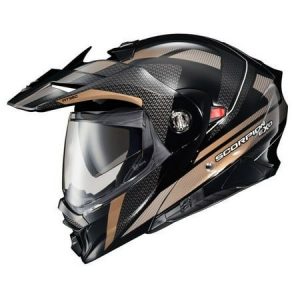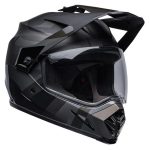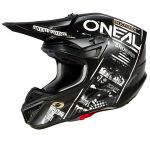Your motorcycle helmet is your most crucial piece of safety equipment. It’s the barrier between you and the pavement in a crash, and choosing the right one is vital for optimal protection and comfort. With a wide variety of helmets available, navigating the selection process can be overwhelming. This comprehensive guide empowers you to make an informed decision and select a motorcycle helmet that perfectly suits your riding style and safety needs.
Understanding Helmet Types: Finding Your Perfect Match
Motorcycle helmets come in various styles, each offering distinct advantages and catering to specific riding preferences. Here’s a breakdown of the most common helmet types:

-
Full-Face Helmets: Offering the most comprehensive protection, full-face helmets enclose your entire head, face, and chin. They feature a visor that shields your eyes from wind, dust, and debris, and some models come equipped with internal sun visors for added convenience. Full-face helmets are ideal for riders who prioritize maximum safety, especially for highway cruising or long-distance touring.
-
Modular Helmets: Also known as flip-up helmets, modular helmets offer the functionality of a full-face helmet with the versatility of an open-face helmet. The chin bar flips up, allowing for easier on and off and increased ventilation during breaks or slower rides. Modular helmets provide a good balance between protection and convenience, making them popular for everyday riding and touring.
-
Open-Face Helmets (3/4 Helmets): These helmets expose your face, offering a sense of freedom and a wider field of view. While comfortable for cruising around town on short rides, open-face helmets provide less overall protection compared to full-face or modular helmets. They are not recommended for high-speed riding.
-
Dual-Sport Helmets: Designed for both on-road and off-road riding, dual-sport helmets incorporate a peak (similar to a baseball cap) to deflect wind, roost (dirt and debris kicked up by other riders), and branches on trails. They often come with visors or goggles to shield your eyes. Dual-sport helmets are ideal for adventure riders who tackle diverse terrains.
Beyond the Shell: Essential Helmet Features to Consider
While helmet type is a crucial starting point, several other features contribute to a helmet’s safety, comfort, and functionality:

-
Shell Material: Most motorcycle helmets utilize a strong, lightweight material like polycarbonate or a composite blend for optimal impact protection without excessive weight.
-
Safety Ratings: Look for helmets that meet or exceed safety standards set by organizations like the U.S. Department of Transportation (DOT) or the Snell Memorial Foundation. These ratings provide assurance that the helmet has undergone rigorous testing and meets specific safety criteria.
-
Visor: Choose a visor with anti-scratch and anti-fog properties for clear vision in various weather conditions. Consider a quick-release system for easy visor changes.
-
Ventilation: Proper ventilation is vital for comfort, especially during hot weather. Look for helmets with adjustable vents that allow airflow to keep your head cool and reduce fogging on the visor.
-
Liner: The helmet liner should be comfortable, breathable, and removable for easy cleaning. Look for moisture-wicking materials to help manage sweat during rides.
-
Weight: A lighter helmet reduces neck strain and fatigue on longer rides. However, prioritize safety over extreme lightweight construction.
Fit is Paramount: Ensuring Your Motorcycle Helmet Protects You Properly
A properly fitting helmet is essential for optimal safety and comfort. Here’s how to ensure your chosen helmet fits you perfectly:

-
Measure Your Head: Use a soft measuring tape to measure the circumference of your head just above your eyebrows.
-
Try Before You Buy: Never purchase a helmet online without trying it on first. Visit a reputable motorcycle gear store and get fitted by a knowledgeable salesperson.
-
Snug But Comfortable: The helmet should fit snugly around your head, without any pressure points. It should not move excessively when you shake your head.
-
Cheek Pad Check: While wearing the helmet, try to gently slide your cheeks in and out. There should be minimal movement.
-
Visor Check: Ensure the visor closes completely and seals properly against the helmet rim to prevent wind or water leaks.
-
Comfort Check: Wear the helmet for at least 15 minutes to assess comfort. Make sure it doesn’t cause any headaches or discomfort.
Safety First: Replacing Your Motorcycle Helmet When Necessary
Even the most well-maintained helmet has a limited lifespan. Here are some signs indicating it’s time for a replacement:

-
Visible Damage: Cracks, deep scratches, or gouges in the shell compromise the helmet’s protective integrity.
-
Loose or Worn Straps: Straps that are frayed, loose, or don’t retract properly can’t secure the helmet effectively in a crash.
-
Liner Deterioration: If the liner becomes excessively worn, frayed, or loses its ability to absorb sweat, it’s time for a new helmet.
-
Impact History: A helmet that has been involved in a crash, even a minor one, should be replaced. The impact can weaken the shell and compromise its safety properties.
-
Age: The lifespan of a motorcycle helmet is generally around 5-7 years, depending on usage and storage conditions. Consult the manufacturer’s recommendations for your specific helmet model.
Finding the Right Balance: Matching Your Motorcycle Helmet to Your Riding Style
The ideal motorcycle helmet caters to your individual riding style and preferences. Here’s how to consider your riding habits when making your choice:
-
Frequent Highway Rider: For riders who primarily cruise on highways, a full-face helmet offers the most comprehensive protection and wind protection for long distances.
-
Off-Road Enthusiast: If you spend most of your time tackling dirt trails and off-road adventures, a dual-sport helmet provides the necessary protection and functionality for off-road riding.
-
Urban Commuter: For short commutes around town, an open-face helmet offers a comfortable and open feel. However, prioritize safety for longer rides or highway commutes by opting for a full-face or modular helmet.
-
Style Considerations: While safety is paramount, motorcycle helmets come in various styles and designs. Choose a helmet that complements your riding style and personal preference, but never compromise safety for aesthetics.
Invest in Your Safety: Reputable Helmet Brands and Where to Buy
With your newfound knowledge of motorcycle helmets, you’re ready to explore your options. Here are some tips for selecting a reputable brand and finding the perfect helmet:

-
Trusted Brands: Look for helmets from established motorcycle gear brands known for their commitment to safety and quality. These brands prioritize rigorous testing and utilize high-quality materials in their helmet construction.
-
Set a Budget: Motorcycle helmets range in price depending on features, materials, and brand. Determine a realistic budget and prioritize safety features over the absolute lowest price point.
-
Shop Around: Visit motorcycle gear stores and compare prices and features from various brands. Don’t be afraid to ask salespeople for recommendations based on your riding style and needs.
-
Online Retailers: While online retailers offer convenience, be cautious when buying a helmet online. Ensure a hassle-free return policy in case the helmet doesn’t fit properly.
Ride with Confidence: Choose the Perfect Motorcycle Helmet for Your Next Adventure
Now that you’ve embarked on a journey through the world of motorcycle helmets, you possess the knowledge and confidence to select the perfect one for your riding needs. Don’t settle for anything less than optimal protection and comfort.
Visit your local motorcycle gear store today! Try on different helmets, get fitted by a professional, and find the helmet that offers the ideal blend of safety, features, and style for you.
Prioritize your safety – every ride! Invest in a high-quality motorcycle helmet and experience the freedom of the open road with complete peace of mind.


